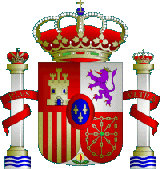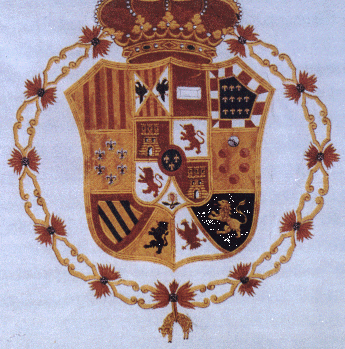The National Arms of Spain

Reference: Faustino Menendez Pidal de Navascues, Heraldica Medieval
Española, Madrid, Hidalguia, 1982. See also the article
by Vicente de Cadenas y Vicent, Puntualización en relación
al nuevo escudo de España, Hidalguia, no 170, 1982.
The arms of the Reyes Católicos, Isabel and Fernando, whose
marriage unified Spain, were:
Quarterly, 1 and 4. quarterly Castile-Leon, 2 and 3. per pale
Aragon and Argon-Sicily. (A representation in black and white can
be found on the seal of the University of
Valencia). The arms were born by the eagle of
San Juan, sable, with an open royal crown. Fernando himself often
used different arms, namely tierced per pale Castile-Leon,
Aragon-Sicily, and Aragon. The conquest of Granada was
symbolized by the addition enté en point of a quarter for
Granada.
The annexation of Naples and Navarra brought about the final change in
the arms of the Rey Católico: the second quarter was changed
to: per pale, 1. per fess Aragon and Navarra, 2. per fess Jerusalem
and Hungary.
The arms as used in Navarra (until 1700) were:
Quarterly, 1. quarterly Castile and Navarra; 2. per pale Aragon and
per pale Leon and Jerusalem; 3. per pale, a. per pale Hungary and Aragon,
b. Aragon-Sicily; 4. quarterly Castile and Leon; enté en point
Granada. The arms used in Aragon were either Aragon,
or per pale, Castile-Leon and Aragon or tierced per pale,
Aragon-Sicily, Aragon and tierced per pale Hungary, Anjou-Naples and
Jerusalem.In Naples, the arms were Quarterly, 1 and 4. Castile-Leon,
2. per pale Aragon and per pale Jerusalem-Hungary; 3. per pale Aragon
and Aragon-Sicily.
Carlos V, from 1516, used as arms a quarterly of Spain (quarterly
Castile-Leon and Aragon-Aragon-Sicily, with Granada enté en point)
and Austria (quarterly Austria, Bourgogne modern, Bourgogne ancient and
Brabant) with an escutcheon overall per pale Flanders and Tyrol. In
1520, the quarter of Aragon and Aragon-Sicily was replaced with a
tierced per pale Aragon, Jerusalem and Hungary (see a color version,
not without inaccuracies, on the seal
of the University of Granada). At the same time,
especially in Flanders, a simplified version appears, which places
the Spanish quarters and the Austrian quarters per fess. In this
case the Spanish quarters are: per pale, Castile-Leon with Granada
and per fess, a. tierced per pale Aragon, Jerusalem and Hungary, b.
per pale Aragon-Sicily and Navarra.
The imperial arms used after 1530 were:
quarterly: 1 and 4. Spain, which is
quarterly A and D. Castile-Leon, B. per pale a. per fess Aragon
and Navarra, b. per pale Jerusalem and Hungary; C. per pale
a. per fess Aragon and Navarra, b. Aragon-Sicily. 2 and 3.
Austria, which is quarterly Austria, Bourgogne modern, Bourgogne
ancient and Brabant. Enté en point Granada. Overall an
escutcheon per pale Flanders and Tyrol.The arms are borne
by an imperial double-headed eagle sable, surmounted by an
imperial crown, surrounded with the collar of the Golden Fleece
and accompanied by the pillars of Hercules and the motto
PLUS ULTRA.
In Sicily Carlos V used Quarterly 1 and 4. Castile-Leon,
2. per pale Aragon and per pale Jerusalem and Hungary, 3. per
pale Aragon and Aragon-Sicily. enté en point Granada.
Overall in chief a double-headed eagle sable crowned or bearing
an escutcheon of Austria. Later, he used quarterly,
1 Castile-Leon, 2. quarterly Aragon, Aragon-Sicily, Navarra
and Aragon, 3. quarterly Austria, Bourgogne modern, Bourgogne
ancient and Brabant, overall an escutcheon per pale Flanders
and Tyrol; 4. per pale Jerusalem and Hungary. Enté en
point Granada, these arms borne by an imperial eagle.
With his son Felipe II came the adoption of the form per pale
Spain and Austria, with the Spanish quarters further simplified.
The resulting arms were:
per pale: Spain, which is quarterly , 1 and 4 Castile-Leon and 2
and 3 per pale Aragon and Aragon-Sicily; enté en point Granada;
Austria, which is quarterly Austria, Bourgogne modern, Bourgogne
ancient and Brabant. Overall an escutcheon per pale Flanders
and Tirol.
From 1580 to 1666 an escutcheon of Portugal was added in honor point,
and the escutcheon of Flanders-Tyrol shifted to nombril point.
In Sicily, the arms used were: per pale, 1. per fess Castile-Leon
and Austria (Austria, Bourgogne modern and ancient and Brabant,
overall Flanders and Tyrol); 2. quarterly Aragon, Aragon-Sicily and
Hungary. These arms remained in use in Sicily until 1700.
Felipe V, grandson of Louis XIV of France, introduced changes in the
royal arms of Spain. THe king's new arms were designed by the French
heraldist Clairambault in November 1700, and were as follows:
per fess: 1. per pale, quarterly Castile and Aragon, enté
en point Granada, and per pale,
Aragon and Aragon-Sicily; 2. Quarterly, Austria, Bourgogne ancient,
Bourgogne modern and Brabant; enté en point, per pale Flanders
and Tyrol. Overall an escutcheon Anjou.
The abbreviated arms were quarterly Castile and Leon, enté
en point Granada, overall Anjou.
In 1761 Carlos III modified the arms as follows:
Quarterly of six (in three rows of two each): 1. per pale Aragon
and Aragon-Sicily; 2. per pale Austria and Bourgogne modern; 3. Farnese
4. Medici; 5. Bourgogne ancient; 6. Brabant; enté en point
per pale Flanders and Tyrol. Overall an escutcheon quarterly of
Castile and Leon enté en point of Granada, overall Anjou.
Around the shield are the collars of the Golden Fleece and of the
French Saint-Esprit.

The abbreviated arms remained the same (they form the
escutcheon en surtout of the state arms). They are accompanied by
the Pillars of Hercules and the motto PLUS ULTRA and crowned with
the royal crown, but do not show the collars. Already at this time
the Anjou escutcheon was sometimes represented without its bordure
gules.
In 1808, Jose Napoleon (brother of Napoleon I of France) proclaimed
a new coat of arms:
Quarterly of 6, in three rows of two each, 1. Castile; 2. Leon;
3. Aragon; 4. Navarra; 5. Granada; 6. Indies (Azure, the old and the
new world or between the pillars of Hercules argent). Overall an
escutcheon with France Imperial.
In 1813 Fernando VII reestablished the arms of Carlos III, both the
state arms and the abbreviated arms. The Anjou escutcheon became
increasingly frequently an escutcheon of France.
The Provisional Government of 1868 adopted the following territorial
arms:
Quarterly, Castile, Leon, Aragon, Navarra, enté en point of
Granada.
The crown was a mural crown. During the brief reign of Amadeo of
Savoia, the crown was a royal crown and an escutcheon of Aosta
(Argent, a cross gules within a bordure compony azure and or) was
placed en surtout.
When the Borbóns were restored with Alfonso XII, a decree (8 Jan 1875)
restored the use of the coat of arms as it stood until September 29, 1868.
In practice the Anjou escutcheon (actually called Borbón
in Spanish) was displayed without the bordure, because the bordure
was considered inessential, and the escutcheon an indication of lineage
from the French Bourbon dynasty. A striking example is given by
the royal arms as they appear on the
reverse of a 5 pesetas coin of Alfonso XII (1885).
The king also used the grand as well as the
abbreviated arms of Carlos III as personal arms. Alfonso XIII did
away with the distinction between state and personal arms by combining
the two. He took the arms of Carlos III, substituted the Aragon
quarter with Jerusalem, and replaced the escutcheon with the former
national arms:
Quarterly of 6, in three rows of two each: 1. per pale
Jerusalem and Aragon-Sicily; 2.
2. per pale Austria and Bourgogne modern; 3. Farnese
4. Medici; 5. Bourgogne ancient; 6. Brabant; enté en point
per pale Flanders and Tyrol. Overall an escutcheon quarterly of
Castile, Leon, Aragon and Navarra enté en point of Granada,
overall France.
The Republic of 1931 used again the territorial arms, while Franco
adopted in 1938 a variant:
Quarterly, 1 and 4. quarterly Castile and Leon, 2 and 3. per
pale Aragon and Navarra, enté en point of Granada.
The arms are crowned with an open royal crown, placed on an eagle displayed
sable, surrounded with the pillars of Hercules, the yoke and the
bundle of arrows of the Reyes Catolicos.
Juan Carlos used as personal arms those of the last kings of Spain,
Alfonso XII and Alfonso XIII, with the closed crown and the collar
of the Golden Fleece. The same arms without the France escutcheon
were already in use in the last years of the Franco regime as
abbreviated arms. By a law of October 5, 1981, Franco's national arms
were abolished and the following state arms were adopted, namely:
Quarterly Castile, Leon, Aragon and Navarra, en surtout Anjou (France
with a bordure gules). Closed crown, pillars of Hercules.

Spanish and Austrian quarters:
- Castile: Gules, a castle triple-towered or, pierced and ajoure
azure.
- Leon: Argent, a lion purpure (or gules) crowned or.
- Aragon: Or, four pallets gules.
- Aragon-Sicily: quarterly per saltire, in chief and base Aragon
and in flanks Argent, an eagle displayed sable.
- Granada: Argent, a pomegranate gules leafed vert.
- Navarra: Gules, a cross, saltire and orle of chains linked
together or.
- Hungary: barry of eight argent and gules.
- Anjou-Naples: Azure, on a semis of fleurs-de-lys or a label
gules.
- Jerusalem: Argent, a cross potent between four crosslets or.
- Austria: Gules, a fess argent.
- Bourgogne ancient: bendy of 6 or and azure, a bordure gules.
- Bourgogne modern: Azure, on a semis of fleurs-de-lys or a bordure
compony argent and gules.
- Brabant: Sable, a lion rampant or.
- Flanders: Or, a lion rampant sable.
- Tirol: Argent, an eagle displayed gules, crowned and bearing
Klee-stengeln on the wings or.
- Portugal: Argent, five escutcheons in cross azure in each as many plates
in saltire, within a bordure gules thereon seven castles or.
- Anjou: Azure, three fleurs-de-lis or within a bordure gules.
- Farnese: Or, six fleurs-de-lis 3, 2 and 1 azure.
- Medici: Or, six balls 1, 2, 2 and 1, tha tin chief of France, the
others gules.
- France Imperial: Azure, an imperial eagle or.